Hyperdimensional Physics, Part II
 This is a annotated version of an original article by Richard C. Hoagland on the subject of “Hyperdimensional Physics.”
This is a annotated version of an original article by Richard C. Hoagland on the subject of “Hyperdimensional Physics.”
In a tragedy for science (if not for society in general) whose outlines we are only now beginning to 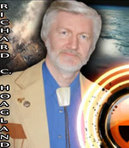 appreciate, after Maxwell’s death, two other 19th Century “mathematical physicists” — Oliver Heaviside and William Gibbs — “streamlined” Maxwell’s original equations down to four simple (if woefully incomplete!) expressions. Because Heaviside openly felt the quaternions were “an abomination” — never fully understanding the linkage between the critical scalar and vector components in Maxwell’s use of them to describe the potentials of empty space (“apples and oranges,” he termed them) — he eliminated over 200 quaternions from Maxwell’s original theory in his attempted “simplification.”
appreciate, after Maxwell’s death, two other 19th Century “mathematical physicists” — Oliver Heaviside and William Gibbs — “streamlined” Maxwell’s original equations down to four simple (if woefully incomplete!) expressions. Because Heaviside openly felt the quaternions were “an abomination” — never fully understanding the linkage between the critical scalar and vector components in Maxwell’s use of them to describe the potentials of empty space (“apples and oranges,” he termed them) — he eliminated over 200 quaternions from Maxwell’s original theory in his attempted “simplification.”
 [Oliver Heaviside, described by Scientific American (Sept. 1950) as “self-taught and … never connected with any university … had [however] a remarkable and inexplicable ability (which was possessed also by Newton and Laplace …) to arrive at mathematical results of considerable complexity without going through any conscious process of proof …” According to other observers, Heaviside actually felt that Maxwell’s use of quaternions and their description of the “potentials” of space was “… mystical, and should be murdered from the theory …” which — by drastically editing Maxwell’s original work after the latter’s untimely death (from cancer), excising the scalar component of the quaternions and eliminating the hyperspatial characteristics of the directional (vector) components — Oliver Heaviside effectively accomplished singlehanded.]
[Oliver Heaviside, described by Scientific American (Sept. 1950) as “self-taught and … never connected with any university … had [however] a remarkable and inexplicable ability (which was possessed also by Newton and Laplace …) to arrive at mathematical results of considerable complexity without going through any conscious process of proof …” According to other observers, Heaviside actually felt that Maxwell’s use of quaternions and their description of the “potentials” of space was “… mystical, and should be murdered from the theory …” which — by drastically editing Maxwell’s original work after the latter’s untimely death (from cancer), excising the scalar component of the quaternions and eliminating the hyperspatial characteristics of the directional (vector) components — Oliver Heaviside effectively accomplished singlehanded.]
This means, of course, that the four surviving “classic” Maxwell’s Equations — which appear in every electrical and physics text the world over, as the underpinnings of all 20th Century electrical and electromagnetic engineering, from radio to radar, from television to computer science, if not inclusive of every “hard” science from physics to chemistry to astrophysics that deals with electromagnetic radiative processes — never appeared in any original Maxwell’ paper or treatise! They are, in fact–
“Heaviside’s equations!”
Lest anyone doubt this is the case, they merely have to read a highly revealing paper on the subject by another renowned British mathematical physicist of this century, Sir Edmund Whittaker, titled simply “Oliver Heaviside” (Bulletin of the Calcutta Mathematical Society, Vol. 20, 1928-29, p.202); or, another overview of Heaviside by Paul J. Nahin, “Oliver Heaviside: Sage in Solitude” (IEEE Press, New York, 1988, p.9, note 3.).
The end result was that physics lost its promising theoretical beginnings to becoming truly “hyperdimensional” physics … over a century ago … and all that that implies.
Georg Bernard Riemann mathematically initiated the 19th Century scientific community (if not the rest of Victorian society) into the “unsettling” idea of “hyperspace,” on June 10, 1854. In a seminal presentation made at the University of Gottinggen in Germany, Riemann put forth the first mathematical description of the possibility of “higher, unseen dimensions …” under the deceptively simple title: “On the Hypotheses Which Lie at the Foundation of Geometry.”
Riemann’s paper was a fundamental assault on the 2000-year old assumptions of “Euclidian Geometry” — the ordered, rectilinear laws of “ordinary” three dimensional reality. In its place, Riemann proposed a four-dimensional reality (of which our 3-D reality was merely a “subset”), in which the geometric rules were radically different, but also internally self-consistent. Even more radical: Riemann proposed that the basic laws of nature in 3-space, the three mysterious forces then known to physics — electrostatics, magnetism and gravity — were all fundamentally united in 4-space, and merely “looked different” because of the resulting “crumpled geometry” of our three-dimensional reality …
In terms of actual physics, Riemann was suggesting something clearly revolutionary: a major break with Newton’s “force creates action-at-a-distance” theories of the time, which had been proposed to explain the “magical” properties of magnetic and electrical attraction and repulsion, gravitationally-curved motions of planets … and falling apples, for over 200 years; in place of Newton, Riemann was proposing that such “apparent forces'” are a direct result of objects moving through 3-space “geometry” … distorted by the intruding geometry of “4-space!”
It is clear that Maxwell and other “giants” of 19th Century physics (Kelvin, for one), as well as an entire contemporary generation of 19th Century mathematicians (like Cayle, Tait, etc.) , took Riemann’s ideas very much to heart; Maxwell’s original selection of 4-space quaternions as the mathematical operators for his force equations and descriptions of electrical and magnetic interaction, clearly demonstrate his belief in Riemann’s approach; and, his surprising literary excursions into poetry — vividly extolling the implications of “higher-dimensional realities” … including musings on their relationship to the ultimate origin of the human soul (above) — emphatically confirm this outlook.
So, how can modern “hyperdimensional physicists” — like Michio Kaku, at City College of the City University of New York — representative of an entirely new generation of physical scientists now reexamining these century-old implications of “hyperspatial geometries” for generating the basic laws of Reality itself, almost casually claim:
“… In retrospect, Riemann’s famous lecture was popularized to a wide audience via mystics, philosophers and artists, but did little to further our understanding of nature … First, there was no attempt to use hyperspace to simplify the laws of nature. Without Riemann’s original guiding principle — that the laws of nature become simple in higher dimensions — scientists during this period were groping in the dark. Riemann’s seminal idea of using geometry — that is, crumpled hyperspace — to explain the essence of a a force’ was forgotten during those years … The mathematical apparatus developed by Riemann became a province of pure mathematics, contrary to Riemann’s original intentions. Without field theory, you cannot make any predictions with hyperspace [emphasis added]…”
— M. Kaku, “Hyperspace”
[ Doubleday (Anchor Books): New York, 1994]
Kaku’s statement belies the entire “modern” outlook on 19th Century physics, and leaves the distinct impression of an apparently unconscious “bias” similar to Heaviside’s, regarding Maxwell’s actual treatment of such matters; certainly, in completely ignoring Maxwell’s true discussion of the importance of the underlying four-dimensional “scalar potentials” for creating such “fields.” And remember: Heaviside also thought of such “potentials” as … “mystical …”
The use of little-known Hamiltonian 4-space quaternions, to represent the effect of “scalar potentials” on electric charges (as opposed to Heaviside’s vectorial descriptions of direct “electric force fields”) obviously have led to great confusion; because … Maxwell’s “scalar potentials” are, of course, nothing short of exactly what Riemann initially proposed–
Quantifiable “geometric spatial distortions” … the exact marriage of hyperspatial geometry and field theory that Kaku and others mistakenly believe (because they’re basing their analysis on Heaviside’s surviving vectorial version of Maxwell’s original “Equations”) is totally missing from this greatest achievement of 19th Century physics!
The major source of confusion surrounding Maxwell’s actual Theory, versus what Heaviside reduced it to, is its math — a notation system perhaps best described by H.J. Josephs (“The Heaviside Papers found at Paignton in 1957,” Electromagnetic Theory by Oliver Heaviside, Including an account of Heaviside’s unpublished notes for a fourth volume, and with a forward by Sir Edmund Whittaker, Vol. III, Third Edition, Chelsea Publishing Co., New York, 1971).
According to Josephs:
“Hamilton’s algebra of quaternions, unlike Heaviside’s algebra of vectors, is not a mere abbreviated mode of expressing Cartesian analysis, but is an independent branch of mathematics with its own rules of operation and its own special theorems. A quaternion is, in fact, a generalized or hypercomplex number … [emphasis added]”
[Apparently, unless a “hyperdimensional theory” is narrowly expressed in terms of a separate technique Riemann himself invented for his own N-dimensional mapping — the so-called “metric tensor” — modern physicists don’t seem to be able to recognize it as a valid higher-dimensional model … not even when it was written in its own, specifically-designed, four-dimensional mathematical notation! (Riemann’s “metric tensor,” BTW, is essentially a graphical checkerboard composed, for a 4-space description, of 16 numbers defining, for instance, field strength at each point in that four-dimensional space. It is NOT written in quaternions.)
And, unless you track down an original 1873 copy of Maxwell’s “Treatise,” there is no easy way to verify the existence of Maxwell’s “hyperdimensional” quaternion notation; for, by 1892, the Third Edition incorporated a “correction” to Maxwell’s original use of “scalar potentials” (contributed by George Francis Fitzgerald — whom Heaviside heavily admired) — thus removing a crucial distinction between 4-space “geometric potential,” and a 3-space “vector field,” from all subsequent “Maxwellian theory.” Which is why Kaku apparently doesn’t realize that Maxwell’s original equations were, in fact, the first geometric 4-space field theory … expressed in specific 4-space terms … the language of quaternions!
Just another measure of Heaviside’s effectiveness …]
One of the difficulties of proposing a “higher dimension” is that, inevitably, people (and scientists are people!), will ask: “Ok, where is it? Where is the fourth dimension’ ..?”
One of the most persistent objections to the 4-space geometries of Riemann, Cayley, Tait … and Maxwell, was that no experimental proof of a “fourth dimension” was readily apparent; one of the more easily understandable aspects of “higher dimensionality” was that, a being from a “lower dimension” (a two-dimensional “Flatlander,” for instance) entering our “higher” three-dimensional reality, would appear to vanish instantly from the lower-dimensional world (and, consequently, appear just as suddenly in the higher dimension — but geometrically distorted.) When she returned to her own dimension, she would just as “magically” reappear …
Unfortunately (or fortunately, depending on your perspective …) to the scientific mind, people in our dimension don’t just “turn a corner one day … and promptly vanish into Riemann’s fourth dimension.'” While mathematically derivable and beautifully consistent, to “experimentalists” (and all real science ultimately has to be based on verifiable, independently repeatable experiments) there seemed no testable, physical proof of “hyperdimensional physics.”
Thus “hyperspace”– as a potential solution to unifying the major laws of physics — after Maxwell’s death, and the major rewriting of his Theory, quietly disappeared … not to resurface for almost half a century …
Until April of 1919.
 At that time, a remarkable letter was delivered to one “Albert Einstein.” Written by an obscure mathematician at the University of Konigsberg in Germany, Theodr Kaluza, the letter’s first few lines offered a startling solution (at least, to Einstein — unknowing of Maxwell’s original quaternion equations) to one of physics’ still most intractable problems: the mathematical unification of his own theory of gravity with Maxwell’s theory of electromagnetic radiation … via introduction of a fifth dimension. (Because Einstein, in formulating the General and Special Theory of Relativity in the intervening years since Riemann, had already appropriated time as the “fourth dimension,” Kaluza was forced to specify his additional spatial dimension as “the fifth.” In fact, this was the same spatial dimension as the 4-space designations used by Maxwell and his colleagues in their models … over 50 years before.)
At that time, a remarkable letter was delivered to one “Albert Einstein.” Written by an obscure mathematician at the University of Konigsberg in Germany, Theodr Kaluza, the letter’s first few lines offered a startling solution (at least, to Einstein — unknowing of Maxwell’s original quaternion equations) to one of physics’ still most intractable problems: the mathematical unification of his own theory of gravity with Maxwell’s theory of electromagnetic radiation … via introduction of a fifth dimension. (Because Einstein, in formulating the General and Special Theory of Relativity in the intervening years since Riemann, had already appropriated time as the “fourth dimension,” Kaluza was forced to specify his additional spatial dimension as “the fifth.” In fact, this was the same spatial dimension as the 4-space designations used by Maxwell and his colleagues in their models … over 50 years before.)
Despite its stunning (Einstein mulled over the paper’s implications for more than two years, before finally supporting its scientific publication) mathematical success, in apparently — finally — uniting “gravity” and “light,” the same question, “OK, where is it?” was asked of Kaluza as had been asked of Riemann, over 60 years before; because, there was no overt experimental proof (for instance, people and things up and “disappearing”) of the physical existence of another spatial dimension. To which Kaluza this time had a very clever answer: he proposed that this “fourth dimension” — unlike the other three we are familiar with — somehow had collapsed down to a tiny circle … “smaller than the smallest atom …”
 In 1926, another essentially unknown mathematician, Oskar Klein, was investigating the peculiar implications of Kaluza’s ideas in the context of the newly-invented atomic theory of “quantum mechanics.” [Klein was a specialist in the truly arcane field of mathematical topology — the higher dimensional surfaces of objects; the twisted 3-D topology of the 2-D surface of a “Klein Bottle” is named specifically in his honor]. Quantum mechanics had just been proposed a year or so before Klein’s further topological investigation of Kaluza’s ideas, by Max Planck and many others rebelling against perceived limitations of Maxwell’s (remember, heavily sanitized by Gibbs and Heaviside) classical Electromagnetic Theory. The “quantum mechanics ” theory would eventually become a highly successful (if bizarre, by common-sense standards) non-geometric effort to describe interactions between “fundamental particles,” exchanging “forces” through discrete “quantitized” particles and energy in the sub-atomic world. Eventually, combining the two inquiries, Klein theorized that, if it truly existed, Kaluza’s new dimension likely had somehow collapsed down to the “Planck length” itself — supposedly the smallest possible size allowed by these fundamental interactions. However, that size was only about … 10-33 cm long!
In 1926, another essentially unknown mathematician, Oskar Klein, was investigating the peculiar implications of Kaluza’s ideas in the context of the newly-invented atomic theory of “quantum mechanics.” [Klein was a specialist in the truly arcane field of mathematical topology — the higher dimensional surfaces of objects; the twisted 3-D topology of the 2-D surface of a “Klein Bottle” is named specifically in his honor]. Quantum mechanics had just been proposed a year or so before Klein’s further topological investigation of Kaluza’s ideas, by Max Planck and many others rebelling against perceived limitations of Maxwell’s (remember, heavily sanitized by Gibbs and Heaviside) classical Electromagnetic Theory. The “quantum mechanics ” theory would eventually become a highly successful (if bizarre, by common-sense standards) non-geometric effort to describe interactions between “fundamental particles,” exchanging “forces” through discrete “quantitized” particles and energy in the sub-atomic world. Eventually, combining the two inquiries, Klein theorized that, if it truly existed, Kaluza’s new dimension likely had somehow collapsed down to the “Planck length” itself — supposedly the smallest possible size allowed by these fundamental interactions. However, that size was only about … 10-33 cm long!
 Thus, the main obstacle to experimental verification of the Kaluza-Klein Theory (and the reason why people simply didn’t “walk into the fourth dimension”), was that quantum mechanics calculations affirmed that the only way to physically probe such an infinitesimally tiny dimension was with a new machine … an “atom smasher.” There was only one small “technical” problem …
Thus, the main obstacle to experimental verification of the Kaluza-Klein Theory (and the reason why people simply didn’t “walk into the fourth dimension”), was that quantum mechanics calculations affirmed that the only way to physically probe such an infinitesimally tiny dimension was with a new machine … an “atom smasher.” There was only one small “technical” problem …
The energy required would exceed the output of all the power plants on Earth … and then some!
Thus, the brief “blip” of new interest in “hyperdimensional physics” — the discussions of Kaluza-Klein among physicists and topologists — “dropped through the floor” by the 1930’s. This occurred both because of Klein’s “proof” of the apparent impossibility of any direct experimental verification of additional dimensions … and because of the dramatic revolution then sweeping the increasingly technological world of Big Science–
The flood of “verifications”gushing forth from atom smashers all around the world, feverishly engaged in probing the new area the experimentalists apparently could verify: the multiplying populations of “fundamental particles”spawned by the bizarre mathematical world (even more bizarre than “N-dimensions”) of Quantum Mechanics.
30 more years would pass … before (almost by mathematical “accident”) in 1968, the current mainstream “flap” of renewed scientific interest in “hyperspace” would be, like the legendary Phoenix, “magically” reborn — a theory now known as “Superstrings” … in which fundamental particles, and “fields,” are viewed as hyperspace vibrations of infinitesimal, multi-dimensional strings … From those relatively inauspicious beginnings, stretching across more than 60 years, the current focus of scientific research papers on “hyperspace” — from continued research into updated versions of the old “Kaluza-Klein Theory”; to discussions of the much newer “Supergravity” hyperspace unification model; to the exotic “String Theory” itself — has grown geometrically (over 5000 papers by 1994 alone, according to Michio Kaku — see above). This much attention to a subject involving realities you can’t even see, represents nothing short of a fundamental psychological revolution sweeping across a major segment of the worldwide scientific community.
For most physicists currently interested in the problem, the “Superstring” hyper-dimensional model has overwhelming advantages over all its predecessors. Besides effectively unifying all the known forces of the Universe … from electromagnetism to the nuclear force … in a literally beautiful “ultimate”picture of Reality, it also makes a specific prediction about the total number of N-dimensions that can form:
“Ten” (or “26,” depending on the rotation of the “strings”).
The bad news is: they can’t be tested either …
As all ten dimensions are curled up (in the model) inside the same experimentally unreachable “Planck length” which spelled the scientific demise of the original Kaluza-Klein …
Impasse.
This, then is the current situation.
The “hottest” mainstream scientific theory to come along in more than half a century, the next best thing to a “Theory of Everything” (and seriously attempting to become precisely that …), is not only a Hyperdimensional Model of Reality … it is another one which, by its fundamental nature–
Can’t scientifically be tested!
While a “hyperdimensional model” which can be tested easily — as this paper will unequivocally show — for over a 100 years has been systematically ignored.
Is it just us … or is there something truly wrong with this picture?
See Part III
Posted in Science For The New Agewith comments disabled.


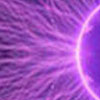
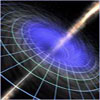
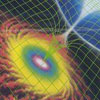
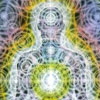
[…] See Part II […]